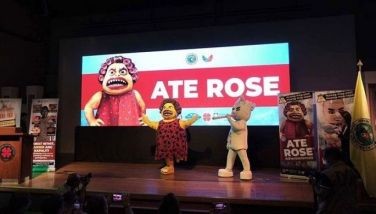Three new books
Three new books crossed my desk recently, each one of them very different from the other, so I thought I’d share a bit of what they have to offer.
The first is decidedly offbeat (for us old fogeys, anyway), but a treat for its target readership: Filipinos in their late 20s and early 30s, that messy age by which some very basic things like loves and jobs should have been sorted out but often aren’t. Carljoe Javier’s The Kobayashi Maru of Love, published by The Youth and Beauty Brigade, is a voyage into romantic disaster, a collection of informal essays about lost girlfriends and other misadventures.
The title derives from a Star Trek episode where the Kobayashi Maru is a distressed transgalactic freighter, and here Carljoe assumes that persona — heavy, rumbling, stuck on some jagged romantic reef. Unlike what you might expect of Carljoe’s Web-worn generation, these aren’t rants, but plaints; his métier isn’t anger but melancholy, that most poetic of postures.
As I observed about a previous book of his, “Like any sharp writer, Carljoe Javier articulates the aches and pains — and the occasional pleasures — of his generation. His typical persona is that of ‘a comic book character driven to the edge,’ speaking in a voice emboldened by fantasy but also tenderized by youth. His characters come coated with a veneer of Western pop culture, but at heart they’re still just people looking for connections, for consequence. ‘He dreamed of touching her,’ Javier writes in one story. ‘She would bring him the things the arcade could not.’ Welcome to the arcade, and welcome to him and her.” So, dudes and dudettes, this one’s for you.
The second book is Where the Children Are, published by ArtPostAsia, written by Gizela M. Gonzalez (also known to her friends as Ging Montinola) and photographed by Jake Verzosa. I couldn’t refuse when the publisher requested me to write a blurb for the book, not just because Ging, a Harvard-trained lawyer, was a sometime graduate student of mine (and one of the finest prose stylists I’ve come across in my classes) but also because — among all the social causes out there — nothing moves me as much as the plight of poor, working children, who should be in school or playing with toys rather than trying to earn a few pesos with their tender limbs.
Not all the chidlren in Ging’s book are in such dire straits, but, as the book’s introduction says, they “live under trying conditions. Yet they face each day with a steadiness and lack of resentment many adults would be hard-pressed to muster: Aninia, twelve, dances in the mountains in the way of her tribe, a way in peril of being lost; Jelwin, twelve, embroiders piña cloth with a craftsman’s calm assurance; Rachelle, also twelve, sleeps atop a tomb; Rochelle, fifteen, and Releonor, twelve, string sampaguita flowers they sell from house to house; Nelson, twelve, the descendant of seafarers, dives from a pier for coins; Paul, thirteen, pushes a cart as he gathers trash to sell to junk shops; Aaron, fifteen, and Czarinah, fourteen, both blind and both nurtured by family and school, move beyond disability’s usual preconceptions; Simon, seven, son of a fisherman, plays the classical violin.”
I had this to add: “In these ten vignettes—each one devoted to a child somewhere in the Philippines — Gizela Gonzalez Montinola provides sensitively drawn, deeply moving portraits of what it is to be young and poor in this country. Whether it’s the story of a boy who embroiders barongs or a girl who loves to dance, these accounts depict not only the sobering realities but also the fervent hopes of these children and their families. Perhaps none is more symbolic than that of the girl who lives in a cemetery in Caloocan — insistent vitality in a place of death, nothing less than a paradigm for the nation itself.”
The last book is my own, co-written with another former student, Antonette Reyes: Builder of Bridges, The Rudy Cuenca Story, published by Anvil and now available at National Book Store.
As my older readers will remember, Rudy Cuenca was the Marcos-era contractor responsible for some of the biggest construction projects of that time. As the back of the book notes, “Though he never finished college, he built the San Juanico Bridge and the North and South Expressways, undertook the massive Manila Bay reclamation project, initiated the export of Filipino labor to the Middle East, and ran the Sheraton, the Pines Hotel, and the Taal Vista Lodge, among many other enterprises. He built the Construction Development Corporation of the Philippines (CDCP) into the country’s largest construction conglomerate of its time. And yet many Filipinos remember him today only as a ‘Marcos crony,’ a tag he will not deny.
“At his heart, however, Rodolfo “Rudy” Cuenca was a builder of bridges—and a witness to some of the most interesting and significant events of 20th-century Philippines. ‘This book was conceived,’ he says, ‘in the hope that a new generation of Filipinos would look back to my life and times and realize — without condoning whatever wrongs and evils may have happened then — that some lasting good emerged out of that period that we can still enjoy and be proud of.’”
This project was particularly interesting for me as a writer, because my initial impulse when I was approached to do it was to say no. I was a martial-law prisoner and had not forgotten the horrifying excesses of that period, and I told Rudy so.
On the other hand, here was an opportunity for a Marcos insider to share his privileged insights into the day-today workings of that regime, the full history of which has yet to be written by far more qualified authors than me. So I let Rudy Cuenca speak for himself — it’s a truly remarkable life, quite apart from Marcos — for interpellation by the scholars and critics.
It’s a good read (if I may say so), so check it out, jog your memory — then make up your own mind.
* * *
Speaking of books, let me just announce and congratulate the winners of this year’s Gintong Aklat Awards, which have been given out every other year since 1981 to outstanding book publishers by the Book Development Association of the Philippines (BDAP). Book entries are judged for all-around excellence, and are subjected to close scrutiny by three professional panels in book manufacture and design, writing and editing.
This year’s winners are: Compendium of the Economically Important Seashells in Panay, Philippines (Liberato Laureta, UP Press), Natural Science; Finding God: True Stories of Spiritual Encounters (Cecilia Manguerra Brainard and Marilyn Ysip Orosa, Anvil Publishing) and Everyday Warriors: The Faces and Stories of Breast Cancer (Jay Lara, Cathy Paras-Lara, UST Publishing), Inspirational; Kulinarya: A Guide Book to Philippine Cuisine (Asia Society Philippine Foundation, Inc., Anvil Publishing), Culinary; Palaspas: An Appreciation of Palm Leaf Art in the Philippines (Elmer Nocheseda, Ateneo Press), Arts and Culture; Ah, Wilderness! A Journey Through Sacred Time (Simeon Dumdum, Jr., Ateneo Press) and The Revolution According to Raymundo Mata (Gina Apostol, Anvil Publishing), English Literature; Pag-aklas Pagbaklas Pagbagtas (Rolando Tolentino, UP Press), Filipino Literature; The Philippines Through European Lenses: Late 19th Century Photographs from the Meerkamp Van Embden Collection (Otto Van Den Muijzenberg, Ateneo Press), Social Science.
* * *
E-mail me at penmanila@yahoo.com and visit my blog at www.penmanila.net.




















